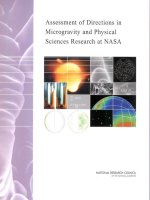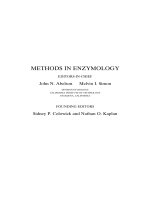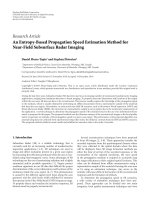X-ray imaging at synchrotron research facilities
Bạn đang xem bản rút gọn của tài liệu. Xem và tải ngay bản đầy đủ của tài liệu tại đây (6.54 MB, 9 trang )
Radiation Measurements 140 (2021) 106459
Contents lists available at ScienceDirect
Radiation Measurements
journal homepage: />
X-ray imaging at synchrotron research facilities
Cyril Ponchut a, *, Nicola Tartoni b, David Pennicard c
a
Detector Unit, European Synchrotron Radiation Facility (ESRF), 71 Avenue des Martyrs, F-38000, Grenoble, France
Diamond Light Source Ltd., Harwell Science and Innovation Campus, Didcot, Oxfordshire, OX11 0DE, UK
c
Photon Science Detector Group, Deutsches Elektronen Synchrotron (DESY), Hamburg, 22607, Germany
b
A R T I C L E I N F O
A B S T R A C T
Keywords:
X-ray detectors
Hybrid detectors
Solid-state detectors
Synchrotrons
At synchrotron facilities, many X-ray imaging and diffraction experiments require pixel detectors with minimal
noise, high speed and reasonably small pixel size, all of which can be achieved with the Medipix ASIC family. So,
ESRF, Diamond Light Source and DESY have developed detector systems based on Medipix. In this paper, we
report on these developments, with an emphasis on the challenges involved building readout systems and the
potential of the Medipix family ASICs in this field of research.
1. Introduction
In the late 1990s most large-area 2D X-ray detectors at ESRF and at
other 3rd generation synchrotron facilities were based on chargecoupled (CCD) sensors optically coupled to X-ray converter screens.
These detectors were, and still are, successfully used for example for Xray diffraction, imaging (Bravin et al., 2004) or spectroscopy with
energy-dispersed beams (Labiche et al., 2007). However some short
comings of large-area CCD systems, like the presence of electronic noise
or the limited speed of the charge transfer readout, make them nonideal
for applications where a large dynamic range, a high detectivity at low
signal level, and/or high frame rates are required. Lag effects as well as
light scattering in the X-ray converter screen also contribute to reduce
the achievable temporal and spatial resolutions.
By providing noise-free, direct detection as well as readout times
below 1 ms, the Medipix2 (Llopart et al., 2002) and the Timepix (Llopart
et al., 2007) photon-counting readout chips were then appearing as a
strong alternative to CCDs in these cases. Then the great leap forward
achieved by Medipix3 (Ballabriga et al., 2013) with higher frame rates,
higher count rates, as well as improved spectroscopic capabilities owing
to the charge summing mode, broadened even more the field of possible
applications at synchrotrons.
Due to their smaller pixel size than other photon-counting pixel de
vices available at that time, Medipix chips also provided the highest
spatial resolution. Moreover, thanks to their compatibility with high-Z
sensor materials working in electron collection mode like CdTe,
CdZnTe, or GaAs, Medipix chips are also enabling synchrotron experi
ments at medium and high energies which is of crucial importance in
particular for ESRF which operates several high-energy beamlines.
By opening the path to an ever extending range of new applications
Medipix chips were therefore undoubtedly promising to a bright future
on synchrotron beamlines. This motivated the development and
commissioning of Medipix-based pixel detectors systems at ESRF, Dia
mond Light Source, and DESY, as depicted in the next sections.
2. Medipix at ESRF
2.1. MAXIPIX detector system
In the early 2000s, soon after joining the Medipix2 collaboration,
ESRF started the development of the MAXIPIX photon-counting detector
system (Ponchut et al., 2011) based on Medipix-2 and later Timepix
readout chips. This project was aimed at bringing the advantages of
Medipix2 and Timepix chips to ESRF beamline users: the noise-free
photon-counting detection, the fast readout time, the small pixel size,
and the wide energy range thanks to the chips compatibility with high-Z
sensor materials like CdTe, CdZnTe, or GaAs. A modular hardware ar
chitecture was retained, in order to facilitate adaptation to specific
beamline requests. A version of MAXIPIX with five Timepix chips (256
× 1280 pixels) is shown on Fig. 1.
This explained the rapid deployment of MAXIPIX detector systems,
nowadays totalling about 21 commissioned units operated in user mode
on ESRF beamlines, plus a few units operated at DESY, Diamond light
source and Soleil synchrotrons., The next sections are a non-exhaustive
review of the MAXIPIX detector –and therefore of Medipix2 and Timepix
chips– applications at ESRF.
* Corresponding author.
E-mail address: (C. Ponchut).
/>Received 4 February 2019; Received in revised form 1 September 2020; Accepted 3 September 2020
Available online 28 October 2020
1350-4487/© 2021 The Authors.
Published by Elsevier Ltd.
This is an open
( />
access
article
under
the
CC
BY-NC-ND
license
C. Ponchut et al.
Radiation Measurements 140 (2021) 106459
Fig. 1. MAXIPIX detector, 5 × 1 version (70 × 14 mm2 input field, 327 kpixels). Left: detector head. Right: Detector module implementing five Medipix2 or Timepix
chips in a row assembled on a monolithic silicon sensor. (For interpretation of the references to colour in this figure legend, the reader is referred to the Web version
of this article.)
Fig. 2. Raman spectrometer at ID20. Left: spectrometer gantry. Right inset: single-chip MAXIPIX detector module.
2.2. Inelastic scattering
The first Medipix2-based X-ray detector commissioned at ESRF was
the focal plane detector of the diced crystal analyzer on ID16 inelastic
scattering beamline (Huotari 2006). This detector consisted of a Medi
pix2 chip with 500 μm thick silicon sensor coupled to the parallel port of
a PRIAM (Ponchut et al., 2007) readout interface, and an ESRF Linux
acquisition workstation. Photon-counting detection was desirable for
efficient detection of the low available X-ray signal at the detector input.
By exploiting the energy-dispersive property of the analyzer and the
small pixel size of Medipix2, the effective energy resolution of the in
strument could be improved from 190 meV to 27 meV (Huotari et al.,
2006), with a detector contribution of only 7 meV thereby leaving room
for further improvement. Later, the Medipix2 module was replaced by a
Timepix module.
Successful use of Timepix in this application led the ESRF to retain
MAXIPIX/Timepix as the detector platform for the new inelastic scat
tering beamline ID20, consisting of two end stations as detailed below:
The ID20 Raman scattering end station consists of a gantry embed
ding six multimirror analyzers, the sample stage and an X-ray focusing
optics as shown in Fig. 2. Each analyzer is fitted with a custom detector
module implementing one single Timepix chip with a 500 μm thick
silicon sensor (Huotari et al., 2017). As the instrument operates in
near-backscattering geometry, a compact detector module with a small
distance between the pixel matrix and the physical edge of the module
Fig. 3. RIXS spectrometer at ID20.
had to be designed. All detector modules are connected to MAXIPIX
controllers with 2 m long VHDCI cables in order to enable independent
motion of each analyzer in a wide angular range. The detectors are
operated simultaneously from the acquisition workstation. The 10 ms
2
C. Ponchut et al.
Radiation Measurements 140 (2021) 106459
detector readout dead time imposed by the cable connection is negli
gible compared to the typical 1–10 s exposure times in this application.
The ID20 Resonant Inelastic Scattering (RIXS) end station imple
ments a five-mirror analyzer fitted with a 5x1 MAXIPIX detector mod
ule, as shown in Fig. 3 (Moretti-Sala et al., 2018). Focusing of each
mirror on a different chip enables individual centering and quality
checking of each focal spot. This instrument can achieve an energy
resolution of 25 meV, about 50% of which is the pixel size contribution.
2.6. Imaging
A MAXIPIX system implementing Timepix chips and a CdTe sensor
with 512 × 512 pixels was used to quantify potential benefits of X-ray
phase contrast imaging (XPCI) for X-ray mammography in terms of
patient dose (Diemoz et al., 2016). Use of phase contrast instead of
absorption contrast allows higher X-ray energies to be used, thereby
reducing the attenuation cross-section of the observed tissue and thus
the radiological dose. The beam energy was 60 keV monochromatic,
instead of the 15–25 keV typical energy with conventional mammog
raphy X-ray tubes. The 1 mm thick CdTe sensor provided nearly 100%
detection efficiency at this energy and the Timepix1 chip spatial reso
lution of 55 μm was ideally suited for breast imaging. The high
signal-to-noise ratio even at low X-ray flux provided by Timepix1 was
also a key feature for dose reduction. As a result, compared to a con
ventional mammography unit the XPCI method with the CdTe MAX
IPIX/Timepix detector achieved a dose reduction from 3.5 mGy to 0.12
mGy on the same breast sample, for images of equivalent diagnostic
value.
2.3. X-ray photon correlation spectroscopy (XPCS)
XPCS is a technique exploiting the coherence of the synchrotron
beam for dynamical studies at nanometre scale of complex fluid systems
like colloidal suspensions, surfactant solutions and thin-film structures
(Gruebel et al., 2004) (Leheny 2012). Initially, XPCS experiments per
formed at ID10 ESRF beamline were using direct detection CCDs
(Gruebel et al., 2004), providing optimum spatial resolution as well as
high sensitivity. However their readout times in the range of seconds as
well as their gradual and irreversible damage under X-ray radiation
were severe limitations. Replacing direct detection CCD by a 512 × 512
pixels MAXIPIX system revolutionized the XPCS technique at ID10 by
improving data statistics and dynamic range (Caronna et al., 2008) and
by giving access to time scales in the ms range (Orsi et al., 2012),
(Fluerasu et al., 2010).
The smaller size of Timepix pixels as compared to any other available
photon-counting device also better matches the typical transverse
coherence lengths of 10 μm × 100 μm (Gruebel 2004) of the ESRF SR
beams used for XPCS experiments.
2.7. High-Z sensor material studies
Medipix2 and Timepix readout chips in combination with finely
focused monochromatic synchrotron X-rays, were also used at ESRF and
other synchrotrons as tools to explore the properties of semiconductor
pixel sensor materials: detailed analysis of CdTe sensors instabilities and
spatial defects (Ruat et al. 2012, 2014), measurement of charge trans
port properties and analysis of the fine structural details of GaAs:Cr
sensors (Ponchut et al., 2017).
2.4. Coherent X-ray diffraction imaging (CXDI), ptychography
3. Medipix3 based detector developments at Diamond Light
Source
These techniques make it possible to perform 2D or 3D imaging of
small isolated objects (CXDI) or of extended objects scanned with a
focused beam (ptychography) at the nanometre scale. Images of the
objects in the direct space are reconstructed from diffraction patterns
acquired in the far-field region (Favre-Nicolin et al., 2017), using inverse
Fourier transform and phase retrieval algorithms.
A CXDI experiment carried out at ID10 using a 2x2 MAXIPIX system
provided 3D images of a sample with a voxel size of 24 nm (Chushkin
et al., 2014). Photon-counting detection combined with frame accu
mulation provided the necessary dynamic range to accurately record the
intensities of the diffraction patterns which can extend over more than 4
orders of magnitude in the same frame. Moreover the small pixel size
allowed the far-field detection geometry to be kept within reasonable
size.
One possible concern with this technique is the high incident in
tensity close to the beam axis which may exceed the counting rate range
of Timepix chip. This can be overcome by inserting a calibrated atten
uator in the central beam path between the sample and the detector.
3.1. Summary and motivation
Diamond Light Source (DLS) has developed a suite of detector sys
tems to exploit the Medipix3 ASICs in photon science experiments.
These systems are Excalibur, a large area position sensitive detector that
tiles 48 ASICs, Merlin, a light and very compact position sensitive de
tector that tiles up to 4 ASICs, and Lancelot, a beam position and in
tensity monitor that uses one ASIC. Excalibur is described in section 3.2
and Merlin and Lancelot are described in section 3.3.
The development of a large area position sensitive detector is the
reason why DLS joined the Medipix3 collaboration. By the time DLS
joined the collaboration in late 2007 it was clear that the photon
counting hybrid pixel detector technology presented many advantages
with respect to the position sensitive detector technologies in use at
synchrotron facilities until then (fundamentally scintillating plates
coupled to CCD imaging sensors by tapered fibre optics bundles).
Particularly important were the capability of providing quantum limited
image noise and to be able to run at much faster frame rate. However,
the only commercially available detector systems had a pixel size too
large for a number of applications. One of these applications at DLS was
the Coherent Diffraction Imaging beam line I13 that was under con
struction. The ideal pixel size for I13 use case was 50 μm which was far
smaller than the 172 μm size of the aforementioned commercially
available system. Thus, a clear science case emerged to develop a de
tector system based on the Medipix3 ASIC which enables to use sensors
whose pixel size is 55 μm and therefore close enough to the ideal
requirement of the beam line I13. Among the drawbacks of hybrid de
tector technology are the relatively limited size of the semiconductor
sensors and the restrictions due to 3-side buttable read-out ASICs. The
use case of I13 required at least in one direction 2000 pixels with no gaps
and at least 1500 pixels in the other direction. The development of a
detector system with such a high channel density was a major challenge.
DLS met such a challenge by developing Excalibur in collaboration with
2.5. Surface and interface diffraction
The characteristics of Timepix chip proved to be particularly well
suited for the study of interfaces, and for this reason most experiments
carried out on ID01 and ID03 beamlines use a MAXIPIX detector. The
fast readout time of Timepix chip combined with the noiseless photoncounting detection allowed novel high data throughput scanning tech
niques to be employed, which would otherwise be impossible due to
prohibitive acquisition times and/or poor data quality. In ID01 for
instance a 2x2 MAXIPIX detector operated at 300 Hz frame rate was
used to acquire 2D diffraction data at every point of a sample scan in X, Y
and ω (incidence angle) positions (Chahine et al., 2014). This experi
ment was totalling more than 9 × 105 data frames acquired in about 3 h,
therefore well within a beamtime shift (8 h). In that case the time
bottleneck was the data processing, not the detector performance.
3
C. Ponchut et al.
Radiation Measurements 140 (2021) 106459
ASICs at Advacam in Finland. The bump bonding technology uses solder
(Pb/Sn) bumps.
The hybrid assemblies are then glued on the top of a molybdenum
base plate and wire-bonded to a printed circuit board (carrier board)
that is glued on the opposite side (rear side) of the base plate. The carrier
board routes the control, data, and power lines to the downstream
electronic equipment (data acquisition card, trigger and power board)
via two 300 way connectors. Each connector reroutes the data control
and power lines of a row of 8 ASICs.
The base plate provides mechanical stability, accurate positioning,
and removes the thermal power generated by the ASICs. The three base
plates are mounted on the heat sink and positioner that guarantees their
accurate relative positioning. Chilled water flows inside the heat sink
and maintains the structure to a constant temperature.
Fig. 4 shows Excalibur partially assembled with the three modules
that are mounted and clearly visible. Further details on the Excalibur
front-end design and fabrication can be found in the literature (Marchal
et al., 2013).
Fig. 4. The three modules of Excalibur mounted on the heat-sink. The flexirigid boards on the back of the sensors are clearly visible and are to be con
nected to the FEM cards.
the UK Science and Technology Facility Council (STFC).
A future application of the Medipix3 ASICs at DLS will be an arc
detector with CdTe sensors for the X-ray Pair Distribution Function
beam line I15-1. The development of the arc detector is ongoing and it is
due to be mounted on the beam line in 2021.
3.2.3. Controls and data acquisition channel
The data lines of each row of 8 ASICs are linked through a 300 way
connector and a flexi rigid adapter to an FPGA data acquisition card,
known as Front End Module (FEM), developed by STFC as data acqui
sition electronics for the Large Pixel Detector project of the European
XFEL (Coughlan 2011). Each FEM card has 3 Spartan3 FPGAs and a
Virtex5 FPGA. Two of the Spartan3 FPGAs are the interface of the board
to the Medipix3 ASICs and are used to distribute and multiplex the
signals. The Virtex5 FPGA is the main engine of the card and it is used for
sequencing, data decoding and data buffering. The Virtex5 FPGA has
dual PowerPC440 embedded processors used to manage the DDR2
memory controller. The third Spartan3 FPGA is used as configuration
controller and boot device.
The ASICs are driven with a clock frequency of 200 MHz and since
the eight LVDS data lines of each Medipix3 ASIC of the row are read out
in parallel, a set of registers of the entire detector (over 3 million 12 bit
registers) is downloaded in 492 μs.
The data are then sent from each FEM card to a Linux PC cluster via a
10 Gbit/s fiber optic link. A 1 Gbit/s copper Ethernet link of each card is
used as control channel and to stream the diagnostic data.
In the first version of Excalibur the data acquisition and control ar
chitecture of the detector system consisted of 6 parallel read-out chan
nels each of those controlling and receiving data from a row of 8 ASICs.
A data acquisition channel was made out of a FEM card, a 10 Gbit/s fiber
optic link and a Linux PC. A cluster of 6 Linux PCs was necessary to drive
the detector. The data were sent from the PC cluster to the remote
storage and recorded in HDF5 format. Each node opened the same file on
the file system and wrote its portion of data in the correct location of the
file so as the full image could be reconstructed (Thompson et al., 2012).
After a couple of upgrades of the infrastructure (new storage file system
and faster data link connecting the beam line to the storage) the parallel
writer data acquisition system managed to be able to deliver a sustained
frame rate of up to 275 frames per second. The frame rate was only
limited by some bottlenecks in the FEM cards and not by the data
acquisition system. However, in order to make the data acquisition
system still more flexible it was finally upgraded to a different hardware
and software architecture.
In the new data acquisition architecture the 10 Gbit/s data links from
the 6 FEM cards are now sent to a deep buffer switch instead of being
connected directly to the Linux PCs. The data acquisition cards that send
the data through the various links send the UDP packets related to a
specific image frame to the same address. Consequently, the deep buffer
switch routes the packets related to the same frame, but coming from
different links, to a single link downstream the switch that is connected
to a Linux PC. Every frame is addressed by the data acquisition cards to a
different Linux PC in a round robin fashion. In this way each Linux PC
operates on the full frame. The Linux PC grabs the frame and writes it to
3.2. The Excalibur detector system
3.2.1. General detector architecture
In order to meet the requirements of the I13 use case, Excalibur tiles
48 Medipix3 ASICs. These ASICs are flip-chip bump-bonded to three
monolithic silicon sensors. The pixel pattern of each sensor is a rectan
gular matrix of 2048 × 512 pixels with 16 ASICs bump-bonded in an 8 ×
2 matrix. The overall sensitive area of Excalibur is therefore 2048 ×
1536 pixels. In one direction there are more than 2000 pixels with no
gap, as required by the use case, and in the other direction more than
1500 pixels with two gaps between the three sensors. These gaps are
indispensable to guarantee the clearance for the control, data, and
power lines which have to be connected to the ASICs through their pe
riphery. Although Medipix3 supports the through silicon via (TSV)
technology, at the time of the approval of the Excalibur project the TSV
technology was not still mature enough to be used without adding
considerable risk, time, and cost.
The ASICs are read out by 6 data acquisition cards. Each card reads a
row of 8 ASICs of a sensor and sends the data to a Linux PC server that in
turn sends the data to the data storage. The data coming from each data
acquisition card therefore are a portion of the overall image (a strip of 8
ASICs in a sensor) and the full image has to be reconstructed before it is
sent to the data storage. This turned out to be a major challenge.
A precision mechanical structure provides the accurate relative po
sitions of the three sensors and acts as a heat sink to remove the heat
generated by the 48 ASICs. Synchronization and power electronics, di
agnostics of temperature and humidity, and a chiller to provide the flow
of cooling water complete the detector system.
3.2.2. Sensors, hybridization, interconnections, mechanical structure
The silicon sensors are fabricated at the Olen plant of Mirion Tech
nologies in Belgium on 6 inch wafers. The thickness of the wafers is 500
μm. The pixels are square with 55 μmpitch in the two orthogonal di
rections so as to match the pitch of Medipix3. The pixels at the boundary
of two ASICs are larger to provide enough clearance to accommodate
two contiguous Medipix3 devices and at the same time to avoid dead
areas in the sensor. The edge pixels are rectangular with dimensions 55
μm × 137.5 μm while the corner pixels are square 137.5 μm × 137.5 μm.
The overall dimensions of the sensors including guard structures are
30.3 mm × 115.7 mm. Only two sensors of such dimensions could be
accommodated in a 6 inch wafer.
The sensors are diced and flip-chip bump-bonded with the Medipix3
4
C. Ponchut et al.
Radiation Measurements 140 (2021) 106459
and the temperature of the hybrids are monitored through appropriate
diagnostic sensors located on the carrier printed circuit board. The data
of the diagnostic sensors are passed to the control software through the
FEM cards that receive them through I2C bus channels. If either the
temperature or humidity exceeds preset values the detector is auto
matically shut down. A comprehensive trigger system enables the users
to synchronize the detector with external events or to synchronize
external equipment with the frames being acquired.
Fig. 5 shows Excalibur fully assembled with the FEM cards and the
rest of the electronics.
3.2.5. Systems deployed at DLS
The first version of the Excalibur used the first version of Medipix3
(Tartoni et al., 2012). Because of some bugs in the first version of
Medipix3 there were some restrictions to the functionality of the de
tector and namely the simultaneous read-out and counting could not
work. The detector in I13 was then upgraded to the bug free version of
the ASIC, Medipix3RXv2, and at the same time a second detector head
was built and rolled out at the Hard X-Ray Nanoprobe for Complex
Systems beam line I14. After that the data acquisition system ODIN-DAQ
was developed and rolled out to the two detectors in I13 and I14.
ODIN-DAQ enabled to exploit at best the capabilities of the detector
head hardware. A third Excalibur detector is under construction and will
be rolled out at the Microfocus Spectroscopy beam line I18 complete
with the ODIN-DAQ. Finally a single module version of Excalibur was
developed (16 chips, 2048 × 512 pixels) and has been rolled out in the
Surface and Interface High Resolution Diffraction beam line I07.
Fig. 6 shows an image of the shadow cast by a poppy taken by
Excalibur during the commissioning at I13.
Fig. 5. The Excalibur detector fully assembled. The three modules on the left
are visible through an aperture of the enclosure flushed with nitrogen. They are
read out by the 6 FEM cards, in the middle of the frame, that in turn stream the
data to the Linux PC cluster.
the data storage independently on the other servers by using the HDF5
Virtual Data Set libraries. The HDF5 VDS present the data to the final
user as if they were a single data set. This architecture is called ODINDAQ (Yendell et al., 2018).
It is possible to operate Excalibur in burst mode where a number of
image frames is acquired at a frame rate up to 2000 frames per second,
stored in the local RAM on the FEM cards, and then streamed to disk
after the acquisition.
3.3. Merlin and Lancelot detector systems
3.2.4. Ancillary equipment
The detector is assembled in a holder that provides mechanical sta
bility and hosts the sensors, the FEM cards, power supply electronics,
high voltage bias supply, and the ancillary trigger electronics. The
sensors are located in an enclosure flushed with dry air or nitrogen in
order to prevent excessive moisture. The humidity level of the enclosure
3.3.1. Merlin
Merlin is a readout system for up to four Medipix3 ASICs based on the
National Instruments (NI) PXIe chassis and embedded controller and an
FPGA card (Horswell 2011; Plackett 2013). The FPGA card is connected
to the detector head (up to 4 ASICs mounted on a chip board and an
appropriate enclosure) through an adapter card that is plugged into the
Fig. 6. Shadow of Ni fluorescence X-rays (7.5 keV) cast by a poppy. The shadow of the tape that keeps the poppy in place is also visible in the upper part of the image.
Definition of the details, contrast and dynamic range of the image, and noise level are well in line with the performance expected by photon counting detectors. The
image is flat field corrected. In the bottom left corner of the image there is a non-working super-column because the related wire was broken.
5
C. Ponchut et al.
Radiation Measurements 140 (2021) 106459
Fig. 7. Merlin ladder (4 × 1) detector head. A small amount of electronics is
located on the detector head. This makes the head very light and compact.
Fig. 8. Photoelectric X-ray absorption efficiencies for typical thicknesses of
different sensor materials (Berger 2010).
FPGA card and through a cable up to 10 m long. The adapter card was
developed at DLS as well as the Merlin software and firmware written in
the LabVIEW graphical programming language. The ASICs on the de
tector head are powered up through the connecting cable and the volt
ages are supplied by the PXIe chassis through an extra module developed
at DLS and plugged into the PXIe chassis. The sensor is also biased
through the connecting cable and the high voltage bias supply is pro
vided by the aforementioned extra module that is controlled by the
Merlin software through the PXIe bus.
Merlin started as a pilot project to gain the knowledge of the Medi
pix3 ASIC necessary to implement the Excalibur detector. However it
was soon recognized that Merlin could be used as a detector system in
synchrotron experiments where the space and weight are at premium.
Since the bulky read-out electronics (PXIe chassis) can be located rela
tively remotely with respect to the detector head it is easy to place the
latter close to the samples and mount it on equipment with weight
constraints such as the diffractometer arm. The Merlin detector heads
come as single ASIC, quads (2 × 2 ASICs), and ladders (4 × 1 ASICs
shown in Fig. 7). 5 Merlin detectors have been rolled out at DLS in some
cases augmenting the capability of certain beam lines. It is the case of
I16 where diffraction imaging experiments can now run. A TCP/IP
interface was added to enable the integration into the standard control
and data acquisition system of the beam lines of DLS. The TCP/IP
interface enables also the system to be controlled over network con
nections from simple clients written in Matlab, LabVIEW, Python, or
other languages.
The Merlin system has been commercialized by Quantum Detectors
for use at synchrotron experiments and more recently for electron mi
croscopy experiments. To date 29 systems have been sold worldwide to
organizations other than DLS.
Fig. 9. LAMBDA detector module. A 42 mm × 28 mm Cr-compensated GaAs
sensor bonded to 6 Medipix3 chips is mounted on the left side of the detec
tor head.
4. Medipix and high-Z sensor materials at DESY
3.3.2. Lancelot
The Medipix3 ASIC found use at DLS also as a beam diagnostic. In
collaboration with the University of Manchester, Lancelot was devel
oped, which is a pinhole camera imaging the radiation scattered by a
foil. The sensor is a silicon sensor bump-bonded to a single Medipix3
ASIC and the entire Lancelot camera is contained in a single enclosure
mounted on the beam line (Kachatkou et al., 2014; Rico-Alvarez et al.,
2014; Garcia-Nathan et al., 2017).
Lancelot is controlled with the same TCP/IP protocol that is used by
Merlin. It operates the ASIC in 6-bit mode and can run at a maximum
speed of 245 frames per second. Lancelot has been deployed on two
beam lines and it is used effectively as beam position and beam profile
monitor (Chagani et al., 2017). The system can measure displacements
of the beam of 1 μm.
4.1. Hard X-ray experiments at synchrotrons
The high speed, dynamic range and sensitivity of photon-counting
detectors such as Medipix have made them the technology of choice in
many X-ray experiments at synchrotrons, particularly X-ray scattering.
Many of these experiments study small samples which do not strongly
absorb X-rays, such as protein crystals. So, these experiments can be
performed at X-ray energies where standard silicon sensors provide high
detection efficiency; for example, 12 keV photons provide a sufficiently
short wavelength to resolve atoms (0.1 nm), and have an absorption
length in silicon of 215 μm. However, some experiments require higher
X-ray energies; for example, experiments studying the internal structure
6
C. Ponchut et al.
Radiation Measurements 140 (2021) 106459
of more absorbent samples (e.g. buried interfaces in fuel cells), and
experiments taking place inside sample environments (e.g. highpressure experiments or in-situ industrial processes). For hard X-ray
experiments, it is advantageous to use “high-Z” (high atomic number)
semiconductors such as GaAs, CdTe or Ge, which have much higher
efficiency as shown in Fig. 8. In particular, investigating changes in
samples on short timescales requires this combination of high quantum
efficiency, low noise and high readout speed offered by photon counting
detectors.
The PETRA-III synchrotron at DESY has a high storage ring energy of
6 GeV, and as a result most beamlines can reach X-ray energies of 30
keV, with specialised hard X-ray beamlines going up to 250 keV. So,
development of Medipix detectors at DESY has placed an emphasis on
building systems using high-Z sensors. The LAMBDA readout system
(Pennicard 2013) built by DESY is designed to work effectively with a
range of high-Z materials, and LAMBDA systems have been built using
CdTe and GaAs as sensors. In particular, large multi-module systems
with 2 megapixel area have been built using GaAs.
Fig. 10. Flatfield X-ray response of a 1000 μm-thick CdTe sensor with 768 ×
512 pixels of 55 μm size, and ohmic contacts.
harmed by high temperatures, so bump-bonding of CdTe is typically
done with softer, low-melting-point solders such as In alloys. The re
sistivity of CdTe is sufficiently high that CdTe sensors with ohmic con
tacts (Pt metal) can be used with Medipix3 readout around room
temperature without excessive leakage current. However, it is also
possible to use other metals to form a Schottky diode.
Fig. 10 below shows the flat-field X-ray response of a CdTe sensor
with 768 × 512 pixels of 55 μm pixel size (42 mm × 28 mm area),
bonded to Medipix3 readout chips and read out by LAMBDA. The sensor
thickness was 1000 μm, and ohmic contacts were used. The X-ray tube
had a Mo anode and 35 kV voltage. The response is not perfectly uni
form, with a visible network of lines present; these are likely due to
dislocations in the material distorting the electric field. However, the
yield of working pixels is high.
The main limitation of CdTe is that its response to X-rays can change
with time and X-ray illumination. Firstly, temporary changes can occur
due to polarization; trapping of charge carriers can lead to a build up of
space charge in the material, changing the electric field and altering the
X-ray response. In particular, high illumination can cause a collapse of
the electric field, leading to low response. For example (Ruat 2014),
reports distortions in the response of a CdTe detector after several hours
of illumination with a relatively modest illumination of 7.105 pho
tons/mm2/s. Permanent damage effects after much higher levels of
irradiation are also reported. These instabilities are also influenced by
the choice of ohmic or Schottky contacts (Astromskas 2016). The impact
of these instabilities depends strongly on the experiment being per
formed. For example, X-ray diffraction from a single crystal will produce
intense diffraction spots (Bragg peaks) whose intensities must be
measured to determine the crystal structure. So, polarization can pre
vent this information from being accurately measured. However, be
tween the Bragg peaks there are much weaker diffraction signals
containing information about crystal shape and defects, and the high
quantum and photon counting capability of this sensor can improve
measurement of these signals.
4.2. LAMBDA readout system
LAMBDA (Large Area Medipix-Based Detector Array) is a modular
readout system for the Medipix3 chip. The LAMBDA module, shown in
Fig. 9, is designed to have a large area (6 by 2 Medipix3 chips), highspeed readout at 2000 frames per second, and to be compatible with
different high-Z sensors. Multiple LAMBDA modules can then be tiled
together to build larger systems.
The detector head of a LAMBDA module consists of one or more
sensors bonded to Medipix3 chips, glued to a ceramic circuit board,
which in turn is glued to a copper mechanical block. The detector head
was designed to mount up to 12 Medipix3 chips in a 6-by-2 arrangement,
giving an array of 1536 by 512 pixels of 55 μm size and an area of 85 mm
by 28 mm. High-Z materials are typically only available in wafers of 3
inch size, which means that the largest Medipix3-compatible sensor
design available is a 3-by-2-chip layout of 42 mm × 28 mm. So, this
detector head design makes it possible to mount either two high-Z
sensors or one large Si sensor. The Medipix3 chips are then wire
bonded to the ceramic circuit board. A ceramic with many thermal vias
was used, rather than an FR4 board, in order to ensure good thermal
conduction from the Medipix3 chips to the cooling block, and to mini
mise thermal stresses in the system by matching the thermal expansion
coefficient of most semiconductors.
The detector head is then connected to a “signal distribution” board,
which provides powering to the detector head and routes the signals
from the Medipix3 chips to a readout board. This readout board has a
Virtex5 FPGA which controls and reads out the detector head. The board
incorporates two 10 Gigabit Ethernet optical links, which makes it
possible to read out the Medipix3 chips at their full speed of 2000 frames
per second (12 bits per image depth) and continuously send the data to a
control PC over the links.
The module is designed so that the readout electronics fit behind the
detector head, allowing multiple modules to be tiled together to cover a
larger area. In multi-module systems, all the detector heads are attached
to a single large water-cooled copper block, and an additional board is
used to fan out control signals from a “master” module to all the others
so that the modules take images simultaneously.
4.3.2. Gallium arsenide
Gallium arsenide is widely-used for applications such as optoelec
tronics, and is readily available in large wafers, which makes it a
potentially appealing option for X-ray detection. However, most GaAs
does not provide the required combination of long carrier lifetime, high
resistivity and large active layer thickness. In particular, high-resistivity
GaAs typically has many electron traps, leading to a low carrier lifetime.
In recent years, most GaAs X-ray detectors used with Medipix have
been made from Chromium-compensated GaAs (Budnisky 2014). This
material is produced by taking n-doped GaAs material with a reasonable
electron lifetime and doping it with Chromium to compensate the excess
electrons. The resulting material has sufficiently high resistivity that it
4.3. High-Z sensor materials
4.3.1. Cadmium Telluride
Cadmium Telluride is a well-established high-Z sensor material, with
a higher quantum efficiency at extreme X-ray energies than Ge or GaAs.
It is commercially available in 3 inch wafers, with carrier lifetimes in the
order of microseconds (Takahashi 2001), which means that signal loss
from charge trapping has little effect in Medipix CdTe detectors. It is
physically more fragile than Ge and GaAs, and its performance may be
7
C. Ponchut et al.
Radiation Measurements 140 (2021) 106459
Fig. 11. Flatfield X-ray response of a LAMBDA module constructed from two 500 μm-thick GaAs sensors, each with 764 × 512 pixels of 55 μm size and
ohmic contacts.
megapixel GaAs detectors (Pennicard 2018). As shown in Fig. 12, these
are constructed from 3 modules, each with 2 GaAs sensors tiles of 42
mm × 28 mm, giving a total pixel count of 1528 × 1536 pixels. Each
module incorporates two 10 Gigabit Ethernet readout links as described
above, allowing images to be continuously taken at up to 2000 frames
per second. The data is received by a pair of server PCs. During exper
iments at the maximum frame rate, it is not possible to process the im
ages and save them to disk in real time, so the data is saved temporarily
in RAM instead; this means this frame rate can be sustained for
approximately 50s, until the RAM is full. This is sufficient for most
high-speed experiments.
These systems have been used primarily at PETRA-III beamline
P02.2, studying materials under extreme pressure in diamond anvil
cells. In these experiments, a sample is compressed between a pair of
diamonds, which can exert pressures comparable to the earth’s core
(hundreds of gigapascals). The structure of the sample can then be
probed by X-ray diffraction, typically using an X-ray energy of 42 keV at
P02.2. The high speed and single photon counting capability of the
LAMBDA system make it possible to record useable diffraction patterns
at 2000 fps, compared to the 10 fps rate normally achieved by typical
flat-panel detectors. As a result, experiments studying rapid changes in
pressure can observe changes on much shorter timescales than before
(Marquardt 2018).
Fig. 12. A 2.3-megapixel GaAs LAMBDA detector, constructed from six GaAs
tiles each of 42 mm × 28 mm.
can be used as a photoconductive sensor at room temperature by
depositing Ohmic contacts. Currently, the Cr-compensation process can
be applied to wafers of up to 4 inches in size.
Fig. 11 below shows the flat-field X-ray response of a Lambda module
built from two Cr-compensated GaAs sensors mounted in a single de
tector head. Like the CdTe sensor above, each individual sensor has 764
× 512 pixels of 55 μm pixel size (42 mm × 28 mm area) and is bonded to
6 Medipix3 readout chips. The sensor thickness is 500 μm, and there is a
10-pixel-wide gap between the two sensors. The GaAs has greater pixelto-pixel variation in response than the CdTe, with a distinctive cellular
structure. Microbeam scans on another sensor show that this variation is
not due to signal loss, but rather to variations in effective pixel size
caused by nonuniformities in the electric field (Ponchut 2017). These
field nonuniformities are due to variations in dopant and defect con
centrations which develop during growth.
While the raw images from GaAs show greater nonuniformity than
CdTe, the behaviour of the material is more stable with time and irra
diation (Hamann 2015) and the image uniformity can be greatly
improved with flat-field correction. As a result, the material can be
effectively used for X-ray scattering experiments, including some dy
namic experiments where the instability of CdTe would cause problems.
However, to perform flatfield correction it is necessary to illuminate the
detector with uniform (or at least smoothly varying) X-rays of the cor
rect energy, with high counting statistics. This can often be inconvenient
when performing experiments at a beamline.
Declaration of competing interest
The authors declare that they have no known competing financial
interests or personal relationships that could have appeared to influence
the work reported in this paper.
References
Astromskas, V., Gimenez, E., Lohstroh, A., Tartoni, N., 2016. IEEE Trans. Nucl. Sci. 63,
252.
Ballabriga, R., Alozy, J., Blaj, G., et al., 2013. J. Inst. 8, C02016.
Berger, M., Hubbell, J., Seltzer, S., et al., 2010. NIST XCOM Photon Cross Sections
Database available />Bravin, A., Fiedler, S., Coan, P., et al., 2004. IEEE Nuclear Science Symposium, Satellite
Workshop on Synchrotron Radiation Detectors, Rome, Italy.
Budnitsky, D., Tyazhev, A., Novikov, V., et al., 2014. J. Inst. 9, C07011.
Caronna, C., Chushkin, Y., Madsen, A., et al., 2008. Phys. Rev. Lett. 100, 055702.
Chagani, H., et al., 2017. J. Inst. 12, C12044.
Chahine, G.A., Richard, M.-I., Homs-Regojo, R.A., et al., 2014. J. Appl. Crystallogr. 47,
762.
Chushkin, Y., Zontone, F., Lima, E., et al., 2014. J. Synchrotron Radiat. 21, 594–599.
Coughlan, J., Cook, S., Day, C., Halsall, R., Taghavi, S., 2011. J. Inst. 6, C12057.
Diemoz, P.C., Bravin, A., Sztr´
okay-Gaul, A., et al., 2016. Phys. Med. Biol. 61, 8750–8761.
Favre-Nicolin, V., Chushkin, Y., Cloetens, P., et al., 2017. Synchrotron Radiat. News 30
(5), 13–18.
Fluerasu, A., Kwasniewski, P., Caronna, C., et al., 2010. New J. Phys. 12, 035023.
Garcia Nathan, T.B., et al., 2017. J. Inst. 12, C10011, 2017.
Gruebel, G., Zontone, F., 2004. J. Alloy. Compd. 362, 3–11.
Hamann, E., et al., 2015. J. Inst. 10, C01047.
Horswell, I., et al., 2011. J. Inst. 6, C01028.
Huotari, S., Albergamo, F., Vank´
o, G., et al., 2006. Rev. Sci. Instr. 77, 0503102.
Huotari, S., Sahle, Ch J., Henriquet, Ch, et al., 2017. J. Synchrotron Radiat. 24, 521–530.
Kachatkou, A., Marchal, J., van Silfhout, R., 2014. J. Synchrotron Radiat. 21, 333–339.
4.4. Large area high-Z systems
The largest high-Z LAMBDA systems built to date by DESY are 2.3
8
C. Ponchut et al.
Radiation Measurements 140 (2021) 106459
Labiche, J.C., Mathon, O., Pascarelli, S., et al., 2007. Rev. Sci. Instr. 78, 091301-091308.
Leheny, R.L., 2012. Curr. Opin. Colloid Interface Sci. 17, 3–12.
Llopart, X., Ballabriga, R., Campbell, M., et al., 2007. Nucl. Instrum. Methods A 581,
485–494.
Llopart, X., Campbell, M., Dinapoli, R., et al., 2002. IEEE Trans. Nucl. Sci. 49 (5),
2279–2283.
Marchal, J., et al., 2013. J. Phys. Conf. 425, 1–5.
Marquardt, H., Buchen, J., Mendez, A.S.J., et al., 2018. Geophys. Res. Lett. 45, 6862.
Moretti-Sala, M., Martel, K., Henriquet, C., et al., 2018. J. Synchrotron Radiat. 25, 1–12.
Orsi, D., Cristofolini, L., Baldi, G., et al., 2012. Phys. Rev. Lett. 108, 105701.
Pennicard, D., Lange, S., Smoljanin, S., et al., 2013. J. Phys. Conf. Ser. 425, 062010.
Pennicard, D., Smoljanin, S., Pithan, F., et al., 2018. J. Inst. 13, C01026.
Plackett, R., et al., 2013. J. Inst. 8, C01038.
Ponchut, C., Cl´
ement, J., Rigal, J.M., et al., 2007. Nucl. Instrum. Methods A 576,
109–112.
Ponchut, C., Cotte, M., Lozinskaya, A., et al., 2017. J. Inst. 12, C12023.
Ponchut, C., Rigal, J.M., Cl´ement, J., et al., 2011. J. Inst. 6, C01069.
Rico Alvarez, O., et al., 2014. J. Inst. 9, C12063, 2014.
Ruat, M., Ponchut, C., 2012. IEEE Trans. Nucl. Sci. 59 (5), 2392–2401.
Ruat, M., Ponchut, C., 2014. J. Inst. 9, C04030.
Takahashi, T., Watanabe, S., 2001. IEEE Trans. Nucl. Sci. 48, 950.
Tartoni, N., et al., 2012. IEEE NSS/MIC Conference Record, pp. 530–533.
Thompson, J.A., et al., 2012. Proc. ICALEPCS’11 894–897.
Yendell, G., et al., 2018. Proc. ICALEPCS’17 966–969.
9









